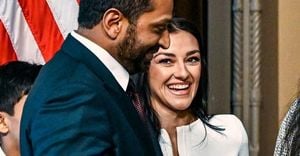For ten years now, an unassuming but powerful tradition has quietly taken root in classrooms and homes across the United States: the StoryCorps Great Thanksgiving Listen. Each November, as families gather for turkey and pie, thousands of students—like those in Stacy Flannery’s history class—pick up their phones or tablets and turn into amateur oral historians, recording the stories of their elders for posterity. According to NPR, this annual project has encouraged a generation of young people to connect with older family members in a way that goes far beyond small talk over mashed potatoes.
It’s a deceptively simple idea. Students are asked to sit down with a grandparent, parent, or other elder, and record a conversation. The goal? To capture the wisdom, memories, and life experiences that might otherwise be lost to time. These interviews, often conducted on smartphones or through the StoryCorps app, are then preserved in the Library of Congress, creating a vast, living archive of American voices. As NPR reports, the Great Thanksgiving Listen has become a staple assignment for teachers like Flannery, who sees it as a way to bridge the generational divide and bring history to life.
“For a decade, StoryCorps’ Great Thanksgiving Listen has encouraged students, including those in Stacy Flannery’s history class, to record the stories of the elders in their families,” NPR wrote in a piece published on November 21, 2025. That’s a remarkable milestone for a project that began with modest ambitions but has grown into a national movement.
But what is it about this project that’s resonated so deeply? Part of the answer lies in its timing. Thanksgiving, after all, is one of the few occasions when extended families are likely to be under the same roof. It’s a moment ripe for reflection, nostalgia, and, sometimes, the sharing of stories that don’t come up in the rush of daily life. The Listen gives students a reason—and, perhaps, the courage—to ask questions they might otherwise shy away from: What was it like growing up during the Great Depression? How did you meet Grandma? What’s the biggest lesson you’ve learned?
For teachers like Stacy Flannery, the Listen is more than just a holiday homework assignment. It’s an opportunity for students to see their elders not just as authority figures or caretakers, but as living witnesses to history. “It’s amazing what comes out when students ask their grandparents about their childhoods or the hardest moments they’ve faced,” Flannery has observed. “They come back to class with a new sense of understanding and respect—not just for their own families, but for the past as a whole.”
The impact of these interviews can be profound. Students often report feeling closer to their relatives after participating, and many say they learn things they never would have guessed. For some, it’s the first time they’ve heard about a grandparent’s struggles as an immigrant, or the challenges their parents faced during turbulent times. For others, it’s a chance to laugh together over family legends or to finally get the real story behind a long-standing mystery. As one student put it, “I thought I knew everything about my dad, but when I interviewed him for StoryCorps, I realized there was so much I’d never asked.”
And it’s not just the students who benefit. Elders, too, often express gratitude for the chance to share their stories—and to know that someone is really listening. In a world obsessed with speed and novelty, the Listen offers a rare pause, a chance to reflect and be heard. Some participants have even described it as therapeutic, a way to make sense of their lives and pass on hard-earned wisdom.
Of course, the project’s reach extends far beyond individual families. By archiving these interviews in the Library of Congress, StoryCorps is building a collective memory—one that reflects the diversity and complexity of American life. The voices captured range from the humorous to the heartbreaking, from the everyday to the extraordinary. Over the past decade, the archive has grown to include stories from every corner of the country, told in dozens of languages and dialects. It’s a living testament to the idea that everyone’s story matters, and that history is made up of countless small moments as much as grand events.
It’s worth noting that the Listen is not just about nostalgia. In classrooms like Flannery’s, students are encouraged to think critically about the stories they hear. What do these memories reveal about the times in which their elders lived? How do personal experiences intersect with larger historical events? What lessons can be drawn for the present—and the future? In this way, the project serves as both a bridge to the past and a prompt for thoughtful discussion about the world today.
The project’s success has not gone unnoticed. Over the years, it’s been featured in major media outlets, and educators across the country have adapted it to fit their own curricula. Some schools have even held listening parties, where students play excerpts from their interviews and reflect on what they’ve learned. The result is a sense of community—and continuity—that’s increasingly rare in our fast-paced, digital age.
Yet, for all its growth, the Listen remains rooted in a simple, human impulse: the need to connect, to understand, and to remember. As another Thanksgiving approaches, thousands of students will once again sit down with their elders, press “record,” and open the door to stories that might otherwise go untold. Who knows what they’ll discover?
In a year marked by rapid change and uncertainty, the enduring success of StoryCorps’ Great Thanksgiving Listen is a reminder of the power of conversation—and the importance of preserving the voices that shape our lives. The tradition shows no sign of slowing down, and as long as families gather and students are curious, the archive will only continue to grow richer, one story at a time.




